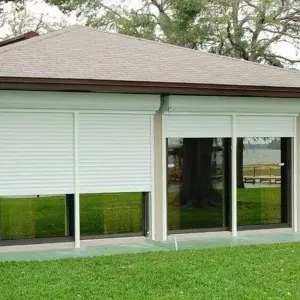What are some tips for debugging rolling shutter doors?
What are some tips for debugging rolling shutter doors?
Rolling shutter doors are a common commercial and industrial door that are favored for their durability, safety, and convenience. However, over time and with frequent use, rolling shutter doors may need to be adjusted to maintain their optimal performance. This article will detail the tips and steps for debugging rolling shutter doors to help you complete this task easily.
Understand the basic structure of rolling shutter doors
Before you start adjusting, it is very important to understand the basic structure of rolling shutter doors. Rolling shutter doors mainly consist of the following parts:
Rolling shutter: Usually made of metal or plastic, it can be rolled up and lowered.
Guide rail: Fixed to the door frame, guiding the movement of the rolling shutter.
Balancing system: Ensures that the rolling shutter door remains balanced when opening and closing.
Drive system: Can be manual, electric, or spring-driven.
Control panel: Used to operate the opening and closing of the rolling shutter door.
Check the balance of the rolling shutter door
The balance of the rolling shutter door is essential for its smooth operation. Before adjusting, check the balance of the rolling shutter door:
Observe the operation: Observe the operation of the rolling shutter door when opening and closing it, and check for any abnormal vibration or noise.
Check the springs: For spring-balanced rolling doors, check that the springs are stretched evenly and are not broken or loose.
Check the balance bar: For balance bar systems, make sure the balance bar is not bent or damaged.
Adjust the rails
Alignment and cleaning of the rails are critical to the smooth operation of the rolling door:
Cleaning the rails: Clean the rails with a mild detergent and a soft cloth to remove dust and debris.
Check the alignment: Make sure the rails are aligned vertically and are not bent or misaligned.
Adjust the rails: If the rails are misaligned, use a screwdriver or wrench to adjust the screws on the rails until they are properly aligned.
Adjust the roller shutter
The tension and position of the roller shutter may need to be adjusted to ensure smooth operation:
Check the roller shutter: Make sure there are no damaged or deformed parts of the roller shutter, which may affect its operation.
Adjust the tension: For spring-balanced rolling doors, adjust the tension of the springs to ensure that the roller shutter remains balanced when opening and closing.
Adjust the position: If the roller shutter is stuck in the rail, adjust its position to ensure free movement.
Check and adjust the drive system
The drive system is the heart of the rolling door and requires regular inspection and maintenance:
Check the motor: For electric rolling doors, check the motor for any unusual noises or signs of overheating.
Lubricate the chain: If the rolling door uses a chain drive, make sure the chain is well lubricated.
Adjust the spring: For spring-driven rolling doors, check the tension of the springs and adjust as needed.
Check and adjust the control panel
The control panel is key to operating the rolling door, make sure it is working properly:
Check the buttons: Make sure the buttons on the control panel are responsive and not stuck or delayed.
Check the indicator lights: If the control panel has indicator lights, check that they are working properly. The indicator lights can show the status of the door and any malfunctions.
Adjust settings: Many modern rolling doors can be programmed through the control panel to adjust the speed of opening and closing, as well as safety features.
Check safety features
Safety is one of the most important considerations for rolling doors:
Check the safety sensors: Make sure the rolling door’s safety sensors are working properly. They can stop the door’s movement if it encounters an obstruction.
Check the emergency release mechanism: Make sure the emergency release mechanism is easily accessible and can quickly release the roller shutter when needed.
Regular testing: Test all safety features of your rolling door regularly to ensure they work properly when needed.
Maintenance and care
Regular maintenance and care can extend the life of your rolling door and ensure its performance:
Regular inspection: Check all parts of your rolling door, including the roller shutter, guide rails, balancing system, and drive system at least once a month.
Lubrication: Lubricate all moving parts regularly to reduce friction and wear.
Cleaning: Keep the rolling door and the area around it clean to prevent dust and debris from accumulating.
Common problems and their solutions
Some common problems you may encounter when commissioning your rolling door:
Roller door stuck: If the rolling door is stuck, check the guide rails for obstructions or damage and clean or repair them.
Roller door is not running smoothly: If the rolling door is not running smoothly, check whether the balancing system and drive system need to be adjusted.
Roller door is too noisy: If the rolling door is too noisy when running, check for loose parts or areas that need lubrication.
Conclusion
Commissioning a rolling door requires a certain understanding of the structure and function of the door. By performing regular inspections and maintenance, you can ensure smooth operation and long-term performance of your rolling door. Remember, safety is always paramount, and make sure all safety features of your rolling door are properly maintained and tested. By following the tips and steps above, you can effectively commission your rolling door, ensuring its optimal performance and longevity.
